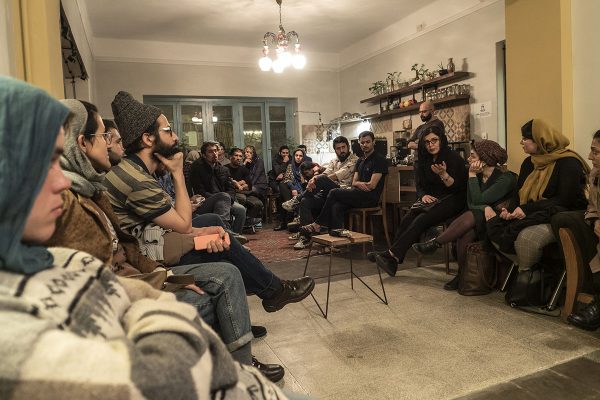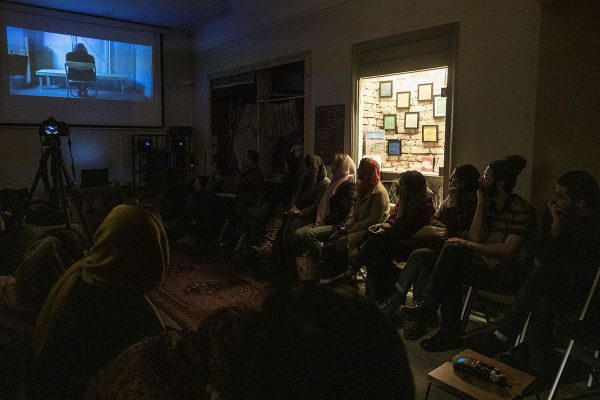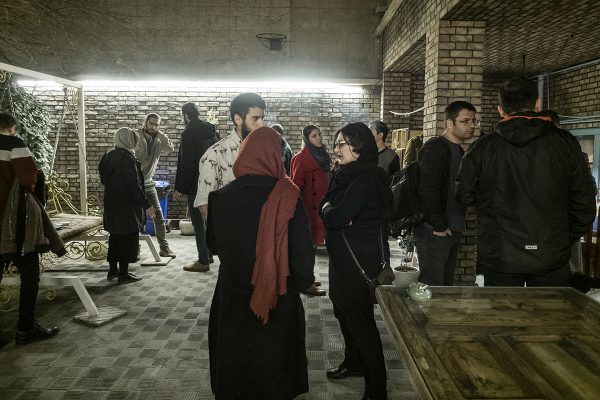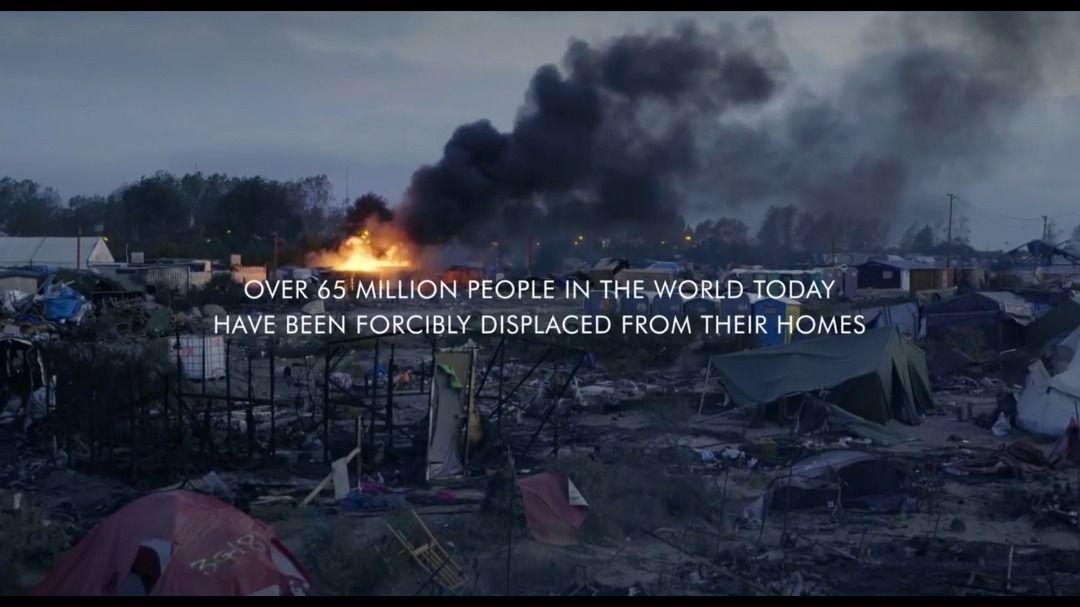What Happened …
Diasporic literature was the topic of discussion at the seventh night of See You in Iran’s migration event series. During the first part of the program Neda Shoaei and Soroush Aa’hi presented parts of their project (Hier und Jetz residency and BLO Ateliers) which essentially is familiarizing the public with authors, thinkers and artists who are concerned or involved with diasporic literature. At the second part of the event a conversation was formed revolving diasporic literature and its specifications.
Migration is a phenomenon beyond geographical relocation. Postcolonial thinkers have proposed ideas regarding migrants’ bonding with the host community, which are embodied in theories like interculturalism, multiculturalism and cosmopolitanism. It is critical to distinguish diaspora which commonly refers to a person who has lived in a country other than their homeland for generations but still have kept their ties culturally from migrant which defines a person who has been relocated but remains closely in touch with their homeland. The intention for migration varies along a continuum. The concept of “home” gains significance when exploring migration. Is it vital for a modern human to have something to refer to as home? Hamid Nafisi explains that home can be anywhere and its changeable in the mind. It can be rebuilt over and over in memories and thoughts.
One of our guests states that integration is the first step for becoming a successful diasporic author and one of the main reasons that there has not been a worthy piece in Persian diasporic literature recently is Iranian migrants are not fluent in the language of the host country or English. This statement was disputed by another guest saying there are successful Iranians in this field specially female writers although an overwhelming difficulty that migrants face is the barrier of language. One of the participants challenges the concept of identity and claims that what remains a struggle for migrants is not what they leave behind and reference to as identity, but language. Another barrier is Publishers of such works that are concerned with the capital and sales first and foremost and it drives the writers to the desired frame of the followership which is the hardships of migration. Therefore they are required to write within a certain boundary if they want their book to be published.
Various authors with different styles write about migration and what in their perspective the process of relocation involves. Sense of nostalgia and alienation are common amongst these literary works. Naipaul, in his masterpiece “A House of Mr. Biswas”, skillfully pictures an Indian’s struggle in the search for identity. Mohsin Hamid who is a Pakistani writer deploys surrealism and magical realism to depict a couple’s struggle and their terrifying experience with migration in “Exit West”. Homi Bhabha uses “Hybridity” under the influence of Walter Benjamin and Edward Saeid to reference multiculturalism and it is the state of Hanif Kureishi’s “The Buddha of Suburbia” protagonist. Tayeb Salih’s Season of migration to the north implements concepts like eurocentrism, hybridity, race, Self/Other and so on to picture the horrendous consequences of neo-colonialism in Sudan.
This was the last night of See You in Iran’s migration event series that was held at our hostel in Tehran. During these events we tried to create a space in which travelers and locals could communicate their ideas directly with each other. Though there still remains a lot to discuss regarding migration, we are happy to have taken a small step towards exploring this phenomenon.
گفتگو در شب هفتم از سری رویدادهای مهاجرت مجموعه See You in Iran حول موضوع ادبیات مهاجرت شکل گرفت. ندا شعاعی و سروش آهی که با انجام پروژههای گوناگون و همکاری با رزیدنسی Hier und Jetz و BLO Ateliers در پی شناساندن هنرمندان، نویسندگان و متفکران به همراه آثار آنها در حوزه ادبیات مهاجرت میباشند، گردانندگان قسمت اول رویداد بودند. در بخش دوم در کنار این عزیزان و دیگر حاضرین به گفتگو درباره ادبیات مهاجرت و خصوصیات آن پرداختیم.
مهاجرت پدیدهای فراتر از جابجایی جغرافیاییست. نظریهپردازان مطالعات پسااستعماری در قالب تئوریهای بینافرهنگی، چندفرهنگی و جهانوطنی به چگونگی پیوند مهاجرین و جامعه مقصد میپردازند. دلایل گوناگونی برای مهاجرت وجود دارد اما در این میان شناخت تفاوت مهاجر و دیاسپورا امری الزامیست. دیاسپورا که به معنی پراکندگیست به فردی گفته میشود که غالبا برای چند نسل پیدرپی در جامعه میزبان زیسته اما همچنان جلوههایی از فرهنگ بومی خود را حفظ کرده است. مهاجر اما فردیست که با وجود اسکان در یک مکان به جایی دیگر تعلق دارد و همچنان ارتباط با میهن خود را حفظ کرده است. “خانه” نیز اهمیت زیادی در مفهوم مهاجرت دارد. آیا برای انسان مدرن ضروریست که مکانی خاص را خانه بنامد؟ به گفته حمید نفیسی خانه هر مکانی میتواند باشد، موقتی و تغییرپذیر است. میتواند بارها در تخیل و خاطرات بازسازی شود.
یکی از میهمانان میگوید ادغام اجتماعی اولین قدم برای تبدیل شدن به یک مهاجر موفق است. نفر دیگری در تایید این گفته اضافه میکند که دلیل فقدان اثری ماندگار، اخیرا، در ادبیات مهاجرت ایران مسلط نبودن ایرانیان به زبان کشور میزبان و انگلیسی است. در مخالفت با این موارد شخص دیگری میگوید آثار خوبی از مهاجرین ایرانی بهویژه زنان در سالهای اخیر منتشر شده است زبان اما همیشه به عنوان چالشی برای مهاجرین مطرح بوده. به گفته یکی از حاضرین هویت ایرانی و الملنهای فرهنگی آن نقشی پررنگ در عدم ادغام مهاجرین ایرانی و شکل نگرفتن حس تعلق اجتماعی در آنها دارد. یکی دیگر از شرکتکنندگان در رویداد از تجربه مهاجرت خود گفت و اذعان داشت که هویت اساسا برای مهاجرین دغدغه ثانویه است و یادگیری زبان کشور میزبان در اولویت اول میتواند برای شکلگیری حس تعلق موثر باشد. نویسندگان آثار مهاجرت با سد ناشرین هم مواجهند. در غالب موارد دغدغه ناشر سود حاصل از فروش آثار و ذائقه مخاطب است. این امر باعث سوق دادن نویسندگان به نوشتن کتابهایی که عموما دربرگیرنده کلیشههای مهاجرت است میشود.
آثار متعددی با سبکهای گوناگون در حوزه ادبیات مهاجرت منتشر شدهاند که در شب رویداد به بررسی برخی از آنها پرداختیم. نایپل نویسنده “خانه آقای بیسواس” با مهارت خاصی تلاشهای مردی هندیتبار را برای یافتن استقلال و هویت روایت میکند. به اعتقاد خیلی از منتقدین این کتاب شاهکار ادبی نایپل و یکی از زیباترین رمانهای انگلیسی زبان معاصر است. او در آثارش حس دلتنگی و بیگانگی را به مخاطب منتقل میکند. محسن حمید، نویسنده پاکستانی تبار با سبک رئالیسم جادویی و سورئالیسم تجربه وحشتناک پناهندگی زوجی را در “فرار به سوی غرب” بازگو میکند که به علت جنگ داخلی مجبور به مهاجرت شدهاند. هیبریدیتی یا پیوندگونی اصطلاحی است که هومی بابا تحت تاثیر والتر بنجامین و ادوارد سعید برای اشاره به موقعیت چندفرهنگی استفاده میکند که موقعیت قهرمان رمان حنیف قریشی به اسم “بودای حومهنشینان” است. “موسم هجرت به شمال”، اثر طیب صالح، جزء صد رمان برتر دنیا است. او در این کتاب با استفاده از مفاهیم ادبی پسااستعماری مانند اروپا محوری، دوگانگی، نژاد و خود/دیگری تصویری هولناک از پیامدهای استعمار نو در سودان ارائه میدهد.
این رویداد آخرین برنامه از سری رویدادهای مهاجرت مجموعه See You in Iran بود که در آن تلاش کردیم با ایجاد فضای گفتگو به بازتاب مسائل مربوط به مهاجرت بپردازیم.
What to Expect
Diasporic Literature is a broad term applicable to all types of literary work written by authors who live outside of their native country though their work comprise of the references to authors’ native culture. Multiple identities, cultural ties and national affiliation are commonly featured is such literary works. During the 6th night of the See You in Iran’s migration event series at our cultural house, we are hosting Neda Shoaei and Soroush Aa’hi who within their projects (Hier und Jetz residency and BLO Ateliers) and collaborations are after familiarizing the public with authors, thinkers and artists who are concerned or involved with diasporic literature. Join us for a discussion regarding the topic on Friday, 22nd of February at See You in Iran Cultural House and Hostel in Tehran at 6:00 PM.









